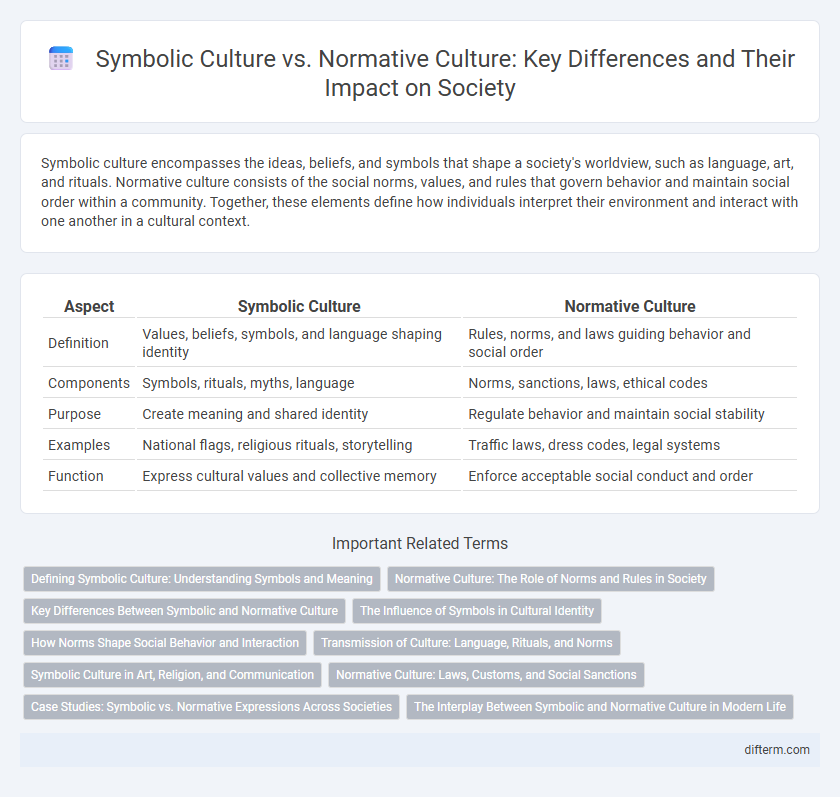Symbolic culture encompasses the ideas, beliefs, and symbols that shape a society's worldview, such as language, art, and rituals. Normative culture consists of the social norms, values, and rules that govern behavior and maintain social order within a community. Together, these elements define how individuals interpret their environment and interact with one another in a cultural context.
Table of Comparison
| Aspect | Symbolic Culture | Normative Culture |
|---|---|---|
| Definition | Values, beliefs, symbols, and language shaping identity | Rules, norms, and laws guiding behavior and social order |
| Components | Symbols, rituals, myths, language | Norms, sanctions, laws, ethical codes |
| Purpose | Create meaning and shared identity | Regulate behavior and maintain social stability |
| Examples | National flags, religious rituals, storytelling | Traffic laws, dress codes, legal systems |
| Function | Express cultural values and collective memory | Enforce acceptable social conduct and order |
Defining Symbolic Culture: Understanding Symbols and Meaning
Symbolic culture encompasses the intangible aspects of culture, including language, symbols, and meanings that shape social interactions and individual identities. It represents shared symbols such as gestures, rituals, and art, which convey cultural values and collective memory within a society. Understanding symbolic culture is essential for interpreting how societies communicate and maintain continuity through abstract representations beyond physical artifacts.
Normative Culture: The Role of Norms and Rules in Society
Normative culture encompasses the shared norms, rules, and expectations that guide behaviors within a society, establishing social order and cohesion. Norms act as unwritten guidelines for acceptable conduct, influencing daily interactions and maintaining group stability. The enforcement of these rules through social sanctions ensures conformity and facilitates predictable social dynamics essential for cultural continuity.
Key Differences Between Symbolic and Normative Culture
Symbolic culture encompasses the meanings, symbols, language, and values that represent a society's worldview, while normative culture consists of the rules, norms, and laws that govern behavior within that society. Symbolic culture shapes identity and social cohesion through shared meanings, whereas normative culture enforces conformity and social order through expectations and sanctions. The key difference lies in symbolic culture's focus on intangible cultural expressions versus normative culture's emphasis on behavioral regulation and societal standards.
The Influence of Symbols in Cultural Identity
Symbols shape cultural identity by embodying shared meanings that convey values, traditions, and beliefs within a community. Symbolic culture includes language, gestures, and rituals that facilitate communication and social cohesion, differentiating groups through distinct cultural expressions. Normative culture, anchored in social norms and rules, guides behavior but relies on symbolic culture for the transmission and reinforcement of those norms across generations.
How Norms Shape Social Behavior and Interaction
Normative culture consists of shared rules and expectations that guide individuals' behavior, ensuring social order and predictability within a community. Norms influence social interaction by defining acceptable conduct, reinforcing group cohesion, and promoting conformity through sanctions or rewards. Symbolic culture, while representing values and beliefs through language and symbols, relies on normative culture to translate these abstract ideas into consistent social practices.
Transmission of Culture: Language, Rituals, and Norms
Symbolic culture encompasses the transmission of meaning through language, rituals, and symbols that communicate shared beliefs and values within a society. Normative culture focuses on the enforcement and perpetuation of social norms, customs, and behavioral expectations that guide interactions and maintain social order. Language acts as a primary medium for conveying both symbolic meanings and normative rules, while rituals reinforce collective identity and adherence to cultural standards.
Symbolic Culture in Art, Religion, and Communication
Symbolic culture encompasses the use of symbols, language, and meanings that shape human experience in art, religion, and communication. In art, symbolic culture manifests through motifs and imagery that convey cultural values and collective identity. Religious rituals and myths rely heavily on symbolic culture to express spiritual beliefs, while communication employs symbols and signs to transmit social norms and shared understanding across communities.
Normative Culture: Laws, Customs, and Social Sanctions
Normative culture encompasses laws, customs, and social sanctions that shape acceptable behavior within a society, serving as a framework for social order and cohesion. Laws codify formal rules enforced by institutions, while customs represent informal practices passed through generations. Social sanctions, both positive and negative, reinforce adherence to these norms by rewarding compliance or punishing deviance.
Case Studies: Symbolic vs. Normative Expressions Across Societies
Symbolic culture encompasses the shared meanings, values, and symbols that define a society's identity, exemplified by rituals and language in Indigenous Australian communities, where Dreamtime stories convey profound cultural beliefs. Normative culture involves the social norms and rules governing behavior, such as Japan's emphasis on etiquette and group harmony, which dictate daily interactions and reinforce social cohesion. Comparative case studies reveal how symbolic expressions, like Native American totem poles, communicate heritage, while normative practices, exemplified by Scandinavian egalitarianism, regulate social conduct and maintain societal stability.
The Interplay Between Symbolic and Normative Culture in Modern Life
Symbolic culture, encompassing language, gestures, and shared meanings, shapes individual identity and social cohesion by providing a framework for interpreting experiences. Normative culture, including laws, customs, and moral codes, dictates acceptable behaviors and maintains social order. The interplay between symbolic and normative culture in modern life manifests as evolving social norms influenced by shifting symbols, such as digital communication altering traditional etiquette and reinforcing new collective values.
Symbolic culture vs Normative culture Infographic

 difterm.com
difterm.com